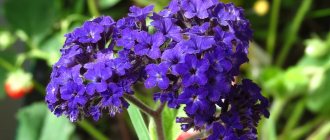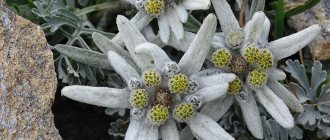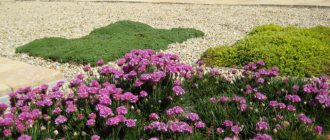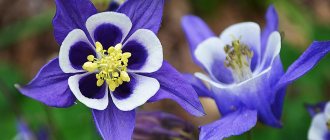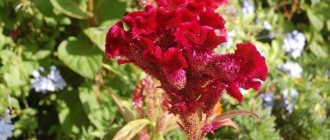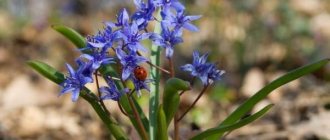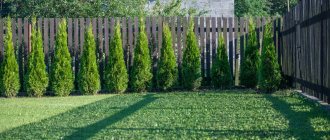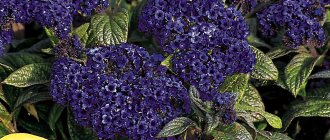The heliotrope flower is hard to miss in the garden; its soft lilac caps of inflorescences invariably attract attention, and if you come closer, you can feel a wave of a delightfully warm spicy aroma. This plant has the amazing property of unfurling its flowering clusters throughout the day, accompanying the path of the sun across the sky. In the natural environment of South America (Peru), heliotrope is a perennial, but planting in the open ground of the middle zone can only be annual due to intolerance to cold weather. However, it is quite possible to preserve the beauty of this Peruvian by taking him from the garden to a warm house and arranging him to spend the winter on the windowsill. Caring for heliotrope during wintering is not difficult - it is only important to maintain a balance of watering and ensure relative coolness.
General description with photo
Heliotrope is an ornamental perennial plant from the Borage family of bushy-herbaceous type.
In indoor conditions it can be grown for several years; in open ground, under any shelter, it dies. The leaves are dark green, wrinkled-wavy, slightly pubescent, which is why they look soft and velvety. They have a convex ovoid shape and are supported by short petioles. The flowers are painted in purple, blue, lilac, dark blue or white tones, collected in large and fairly dense corymbose inflorescences with a diameter of up to 20 cm.
In addition to their high decorative properties, they are valuable for their essential oil content, the subtle spicy smell of which is widely used in perfumery. The bushes can reach a height of just over half a meter.
Heliotrope blooms in mid-summer, flowering of ordinary species and varieties lasts about a month, new hybrid varieties can bloom until late autumn. Then the coenobium fruit ripens on the peduncle, eventually breaking up into 4 parts (erems). Each of the erems contains small seeds of the plant.
Heliotrope has varieties whose stems contain the alkaloid cynoglossin, which is poisonous to humans and animals and has a paralyzing effect on the central nervous system. Another poisonous alkaloid is contained in its seeds (lasiocarpine), but, as a rule, these species are not grown in culture.
When and how to collect seeds
Since outdoor Heliotropium is an annual crop, it is usually dug up at the end of the flowering period. If you decide to collect seeds yourself for future seasons, then this must be done before the flower is dug up.
Attention! You can start collecting seeds when the flowers become wilted and darker in color.
In their place, boxes with seeds appear. It is necessary to carefully pick off these boxes, and then remove and sort out the seeds. The collected seed is thoroughly dried and left for winter storage, pre-wrapped in paper.
Popular varieties of heliotrope with photos
The plant has a huge number of botanically described and undescribed varieties, however, no more than five of them are grown in Russian gardens.
Heliotrope tree (Peruvian)
Serves as the basis for the creation of numerous varieties and hybrids. A typical representative of the species is up to 60 cm tall, blue-violet in color and forms dense, densely leafy bushes. The short-petiolate leaves are distinctly wrinkled, slightly pubescent, and ovoid in shape.
The most popular variety series of the Peruvian variety is Marin, characterized by a purple tint of dark green foliage and deep purple inflorescences. The shortest representative of the species is the Mini Marine variety, barely reaching 35 cm in height and blooming with bright blue-violet buds. Also very popular are the varieties Regal Dwarf, which is compact, and White Lady, whose flowers initially have a pinkish color, and when fully bloomed, become pure white.
The “Black Beauty” variety, with purple tassels and a delightfully delicate aroma, is slightly ahead of it in growth.
The pride of the breeders is the “Fragrant Delight” variety, which has a lavender color of varying intensities moving from the middle to the edges.
Heliotrope corymbose (corymbose)
Compared to the previous species, it has larger inflorescences and narrowed leaves. In addition, it differs from all others in its greatest height, which in some cases can reach a meter or more. The leaf blades are lance-shaped, similar to a boat. The leaves are less richly colored on top than on the bottom. It blooms in blue-blue tones; the bred hybrids are able to continue flowering until frost.
European heliotrope
Places of natural growth are the Mediterranean region and South America. The strongly branching stem grows up to 40 cm, covered with oblong foliage that has a light green-yellow color. A characteristic feature of the buds is their “curliness” due to the shape of the curled petals. Thanks to this, the inflorescences look incredibly lush and dense. Flowering continues until the end of summer.
Heliotrope Kurasavsky
Forms lush and spreading bushes of considerable height. The flowers are painted in pale blue tones, sitting on tall and strong peduncles.
Heliotrope stem-encompassing
Not the most popular among gardeners is a low-growing variety with long, wavy, pointed leaves along the edge. Blooms in rich purple color.
The name of the flower in Greek reflects its ability to turn after the sun - “helios” (sun) “plus” trope (turn).
Indoor growing option
As mentioned above, this plant can be not only garden, but also indoor. With the second cultivation option, its “life” lengthens significantly. Caring for a flower growing in a house or apartment is similar to the outdoor version. Only one variety of Heliotropium, called Peruvian, is suitable for indoor growing.
The most important point is to ensure the flower is at the proper temperature. So, in summer the plant needs a temperature of about twenty-five degrees Celsius, and in winter about six.
Indoor heliotrope, unlike outdoor heliotrope, requires regular feeding with special fertilizers throughout flowering. As a rule, this plant pleases its owners with bright flowers from May until the end of summer.
Attention! The presence of a pronounced odor makes the flower dangerous for people with allergies. Therefore, before planting it is recommended to do appropriate tests for the presence of allergens.
Heliotrope care
Proper planting makes caring for the plant much easier, so it is important, first of all, to decide on the location, especially when planting in open ground. If in the future it is planned to grow heliotrope as a perennial, you should immediately take care of moving it indoors for the winter. The best solution would be to plant in a pot that is dug into the area. But the size of the root system allows it to be dug up to be transferred to a planting container.
Soil requirements
Fertility and good aeration properties are the main soil requirements for this flower. For planting in a pot, it is better to use a ready-made mixture for flower crops or seedlings. It is recommended to mix equal amounts of humus, sand and high-moor peat on the site. In any case, it is very advisable to disinfect the substrate by pouring it with a strong manganese solution or calcining it, if possible, in the oven.
Watering
A care point to which the culture is very demanding. The soil should always be permanently moistened, but within moderate limits. Drying out the substrate leads to loss of decorativeness, and its overmoistening leads to fungal diseases. When growing in summer cottages, when there is no possibility of regular, timely watering, it is worth using mulch that retains natural moisture for a long time. Mown and slightly dried grass, buckwheat husks (looks very decorative and allows you to avoid thickening the planting), sawdust, and shavings are well suited for it. Mulch will benefit plants even in rainy weather, eliminating the contact of the above-ground part with the ground.
Top dressing
You can start feeding the plant a couple of weeks after planting the seedlings in open ground, followed by a 2-week alternation of organic matter and mineral complexes. The best time for this is in the evening after watering.
Heliotrope flower: use in landscape design
Heliotropes are herbaceous plants for open ground, which are often used to decorate flower beds and create living borders.
Its strong bushes, abundantly decorated with flowers, will also look good in flower pots on open terraces and recreation areas.
Considering the fragrance of flowers, located not far from recreation areas, they saturate the atmosphere with a delicate aroma of vanilla, making it more comfortable and pleasant.
Wintering heliotrope
The climate of temperate latitudes leaves no hope of preserving the flower in open ground. To preserve the plant, you need to carefully dig it up and plant it in a pot, the size of which allows you to preserve the root system as much as possible. This should be done shortly before the first frost, but it is better to wait until the budding period ends if this is a long-flowering variety. The temperature at home should be low, optimally within +16...+18C, but the lighting requirements are almost summer-like. Therefore, it is advisable to place the flower in a place where there is additional lighting in the evening and morning. Throughout the wintering period, you should follow the usual watering regime without drying out the roots or overmoistening them.
Heliotrope overwintered at home can serve as an excellent source of planting material for vegetative propagation next year.
Heliotrope after the end of the flowering period
How and at what time should you collect seeds?
Even an inexperienced gardener can plant such a plant and care for it. But not everyone can cope with generative propagation, especially if the seeds were collected from their own garden. This propagation process is quite complicated and a positive result occurs only in rare cases, because the seeds in the middle zone simply do not have time to ripen normally. It is worth thinking about whether it is necessary to spend time and energy collecting seeds, from which, at best, not very beautiful plants will grow. It is much easier to sow purchased seeds, from which beautiful flowers are guaranteed to grow. But if you really want to try growing heliotropes from seeds collected with your own hands, then you will need to wait until the inflorescence withers, dries out and turns black. Then it is carefully torn off and small seeds are extracted from it. The extracted seeds must be sorted out, dried and poured into a cardboard box for further storage.
Heliotrope in winter
Since it is grown as an annual, the bushes are simply destroyed in the fall, because the land will need to be fertilized and dug up. However, if you want to grow such a plant at home in winter, you need to dig up the uterine part of the flower before the first frost, plant it in a flower pot and bring it home. Heliotrope will need additional lighting, as well as coolness (15–18 degrees), in which case it will bloom for a very long time, filling the room with a unique aroma. In spring, if necessary, cuttings can be taken from such a flower and rooted.
Growing heliotrope from seeds
This method does not guarantee results, since the seeds may simply not ripen in an insufficiently warm climate. The main problems of heliotropes grown from low-quality seeds are late flowering, uneven height of bushes, and small inflorescences. In addition, in hybrids they may not produce parental characteristics. But, of course, you can try your luck.
How to collect seeds?
Seed material should be collected only after the plant has not just blossomed and withered, but has dried out and completely turned black. Only in this case is there a chance to get ripened seeds. The cut inflorescences are peeled onto paper, dried and stored in a paper bag or cardboard box.
When and how to plant?
It is best to plant heliotrope seeds for seedlings in February, the deadline is in March. The prepared disinfected substrate should be compacted using a plank. The seeds are poured on top of it and evenly distributed, after which the top layer of soil is poured and also lightly compacted. The embedment depth is 1-2 mm. The container is covered with transparent material and placed in a warm place. Shoots may appear unevenly, but after the first, the shelter must be removed. The plants do not require bright lighting; it is enough to place the seedling container in a regular bright place, this will not affect their development.
Picking
Picking with root pinching is done at the stage of two true leaves. You can immediately plant the seedlings in individual containers. After 2 weeks, it is recommended to use seedling fertilizer.
Planting in open ground
The time for planting in an open place is June; the return of frost should be completely excluded. It is advisable to choose a well-lit place. Transplantation is carried out by transshipment.
How to water a sunny flower
Heliotrope equally does not tolerate prolonged drought and excessive moisture, so you need to be extremely careful when watering the flowerbed. Moisten the soil when the top layer dries slightly, but do not use too much water, as this will cause rotting of the roots. In general, keep an eye on the weather and keep the soil slightly moist, but not wet.
The plant responds well to sprinkling. Carry out this activity in the morning or evening, otherwise the delicate foliage will get burned. For spraying, use exclusively warm water, heated by the sun's rays during the day.
Propagation by apical cuttings
If a flower overwinters at home, it is very convenient to obtain planting material from it in the form of apical shoots. They are cut in February-March, the length of the cuttings is 4-5 cm. The lower leaves are completely removed, the upper pair is shortened by half. All existing sections are treated with ash, crushed coal or chalk, but it is best to use Kornevin powder or use another root formation stimulator. Planting is best done in large peat tablets. Care is usual, as with seedlings; transfer to open ground is carried out with the onset of consistently warm weather.
How and when to sow: step-by-step instructions
The most favorable period for sowing will be the last winter or first spring days. To obtain healthy Heliotropium seedlings, it is necessary to correctly perform a number of sequential operations:
- We prepare the substrate for sowing according to the following recipe: peat – 4/5 parts; sand – 1/5 part.
- To prevent fungal infections, the prepared soil must be thoroughly steamed and then calcined.
- We thoroughly wash the container intended for sowing.
- Carefully pour the substrate into the prepared container, level the surface and compact it a little.
- Preparing the seeds. Since the seeds are small in size, they must be scattered evenly over the ground and then lightly sprinkled with soil.
- It is advisable to cover the seeds with film or glass for better germination.
- At the initial stage, we provide the seedlings with a temperature regime of about twenty degrees Celsius. After the first shoots appear, we remove the greenhouse and raise the temperature by a couple of degrees.
- For good germination, the soil must be regularly moistened by spraying.
- For optimal growth, “babies” need to be provided with lighting for at least ten hours throughout the day.
- When two or three true leaves appear on the sprouts, they must be planted in separate small pots or cups.
- After planting the “babies” they need to be watered thoroughly.
- Two weeks after picking, young plants must be fed using a special fertilizer.
Pests and diseases
When there is an excess of moisture, especially against the backdrop of cool conditions, for example, in a rainy, cold summer, heliotrope is often affected by gray rot, as well as rust. Any of the suitable fungicides (Maxima, Diskora, Strobi, etc.) will provide first aid to the plant. The treatment must be repeated in compliance with the interval specified by the manufacturer for this product.
Of the pests, the most common uninvited guests are whiteflies, spider mites and the ubiquitous aphids. Treatment is also standard using industrial insecticides (Aktellik, Funafon, etc.).
Rules for planting seedlings in open ground
You can only plant heliotrope seedlings if you are completely sure that there will be no more frosts. Otherwise, by planting seedlings early, you can destroy them without wanting to. So, the depth of the holes for seedlings should be slightly greater than the depth of the container for seedlings. The distance between flowers should be at least 25 cm.
Before transplanting, you need to put a small layer of sand at the bottom of the hole, after that the soil in the container needs to be slightly moistened and carefully pull out the seedling along with the lump of earth and transfer it to the hole. Next, dig in the hole and lightly compact it.
During this procedure you need to be extremely careful; the shoot of a young plant is very thin and can easily be broken. After transplanting is completed, the seedling needs to be watered a little. Before the first flowers appear, the plant needs to be fed every two weeks.
Try to choose a well-lit place for the flower bed, otherwise the flowers will look very sluggish and will often get sick. In addition to watering and fertilizing, you need to periodically loosen the soil around the plant, this will only be beneficial.
Medicinal properties
In addition to its delicious smell, heliotrope also has some medicinal properties that are used by experienced herbalists. This is an anthelmintic effect, external burning of warts and treatment of lichen, as well as the ability to help with kidney stones. However, independent use of the plant for medicinal purposes is extremely dangerous and is categorically not recommended by doctors due to the possible content of toxic alkaloids. Thus, recently the plant in this capacity was withdrawn from sale and banned by health authorities in Germany.
How to prepare for landing
Having determined the timing of sowing seedlings, begin preparing for work. Heliotrope seeds are not uncommon and are sold in various stores. You can prepare them yourself. Before sowing, “your” seeds need to be soaked for 20–30 minutes in a weak solution of potassium permanganate or in “Fitosporin-m”, diluted according to the instructions.
The soil can be purchased at the store or made with your own hands. The soil needs to be loose and nutritious. Heliotrope has no special preferences for soil, so you can buy “universal”, “for seedlings”. When preparing it yourself, take:
- compost or universal soil - 2 parts;
- peat - 2 parts;
- river sand or vermiculite - 1 part.
Self-prepared soil must be disinfected to prevent the occurrence of fungal diseases. It can be shed with a solution of potassium permanganate (weak) or a solution of Fitosporin-m. If the containers have been previously used, they must be washed with laundry soap and rinsed with boiling water. Then dry it and only then fill it with soil.
| On a note. Low plastic containers or seedling cassettes are suitable as seedling containers. All containers should have drainage holes in the bottom. |
Photo pexels/Greta Hoffman: Low plastic containers are ideal for sowing.
